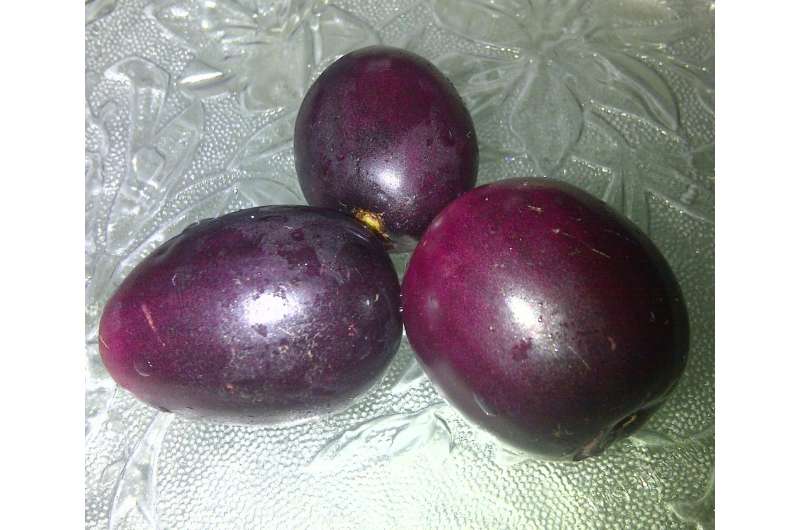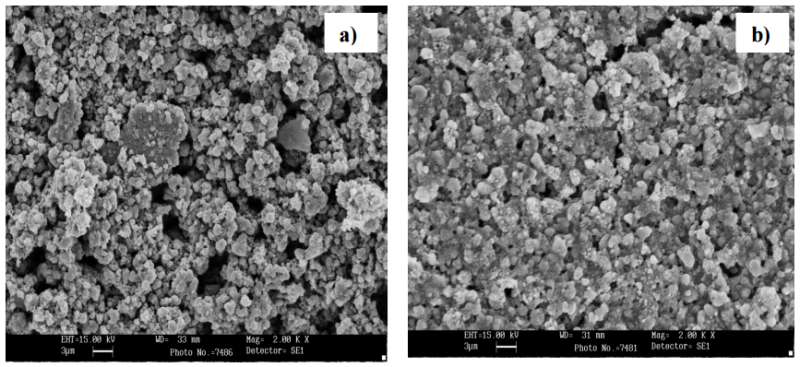Credit: Wikipedia/CC BY-SA 4.0
(Tech Xplore)—Could a fruit in India—long known for its nutritional and medicinal value—and often sold at a low price on pavements and at traffic junctions—-make solar cells cheaper and more efficient?
A report in Quartz looks at researchers on that very path. "A group of researchers at the Indian Institute of Technology (IIT), Roorkee, have found that a pigment found in jamun (Syzygium cumini) absorbs large amounts of sunlight," said Quartz.
From the Indian Institute of Technology (IIT), Roorkee, they want to explore the use of commonly available fruits in the country, for making solar cells cheaper and more efficient.
Which fruits? The researchers turned to black currants, berries and a black plum fruit called jamun. Indian Express described the latter as a "juicy, delectable Indian summer fruit."
In brief, researchers used naturally occurring pigment as an inexpensive photosensitiser, said a Press Trust of India report appearing last month.
They were able "to fabricate Dye Sensitized Solar Cells (DSSC) by extracting the anthocyanins—or the plant pigments—" from these items, said EcoWatch.
How they fabricated the DSSCs:
In their paper "Utilization of Naturally Occurring Dyes as Sensitizers in Dye Sensitized Solar Cells," the authors Nipun Sawhney, Anubhav Raghav and Soumitra Satapathii wrote, "Dye sensitized solar cells (DSSCs) were fabricated with four naturally occurring anthocyanin dyes extracted from naturally found fruits/juices."
(Anthocyanins are plant colorants; they are responsible for the red, purple, and blue hues you see in some fruits, vegetables, and cereal grains.)
SEM images of (a) bare TiO2 layer and (b) anthocyanin dye loaded TiO2 layer. Credit:
The team turned to jamun, plum, black currant, and berries as sensitizers.
"Anthocyanins are naturally occurring biodegradable and nontoxic molecules that are extracted using techniques that involve negligible low cost to the environment and therefore can provide ecofriendly alternatives to synthetic dyes for DSSC production."
Acidified ethanol was used for the extraction of anthocyanin.
The highest power conversion efficiencies were achieved for the DSSCs fabricated using anthocyanin extracts of blackcurrant and mixed berry juice.
In an article in Quartz about their research, Manu Balachandran wrote about Soumitra Satapathi, assistant professor at IIT-Roorkee, and co-author of the paper. Balachandran wrote, "By using naturally occurring dyes like the jamun pigment, Satapathi hopes that if he can make his dye-sensitised solar cell more efficient, it could bring down the cost of a solar panel by 40%."
In the bigger picture, manufacturing silicon cells is quite expensive, said Quartz, and the writer expanded on the cost factor. "Most solar cells today are made of either single crystal silicon or polycrystalline silicon. While polycrystalline is more efficient, it is also more expensive."
The Press Trust of India report relayed the researchers' view on solar power in India. "Uncertainty over the pace at which new large dams or nuclear plants can be built means strong reliance on solar power—an area where India has high potential and equally high ambition—to deliver on the country's pledge to build up a 40 per cent share of non-fossil fuel capacity in the power sector by 2030, researchers said."
In brief, solar power is viewed as an important alternative in a goal to reduce dependence on fossil fuels.
Nonetheless, Balachandran presented some difficulties. "Satapathi's cell current efficiency is only 0.5% compared to commercial solar cells that provide more than 15% efficiency." Quartz also said that there are no large commercial suppliers of solar panels that use this technology today because of the poor efficiency of the cells.
Akshat Rathi contributed to the Quartz report. The researchers' article has been published in the Journal of Photovoltaics.
More information: Nipun Sawhney et al. Utilization of Naturally Occurring Dyes as Sensitizers in Dye Sensitized Solar Cells, IEEE Journal of Photovoltaics (2017). DOI: 10.1109/JPHOTOV.2016.2639343 , On Arxiv: arxiv.org/abs/1512.02217
Abstract
Dye sensitized Solar cells (DSSCs) were fabricated with four naturally occurring anthocyanin dyes extracted from naturally found fruits/ juices (viz. Indian Jamun, Plum, Black Currant and Berries) as sensitizers. Extraction of anthocyanin was done using acidified ethanol. The highest power conversion efficiencies ({eta}) of 0.55% and 0.53% were achieved for the DSSCs fabricated using anthocyanin extracts of blackcurrant and mixed berry juice. Widespread availability of these fruits/juices, high concentration of anthocyanins in them and ease of extraction of anthocyanin dyes from these commonly available fruits render them novel and inexpensive candidates for solar cell fabrication.
Journal information: arXiv
© 2017 Tech Xplore

























